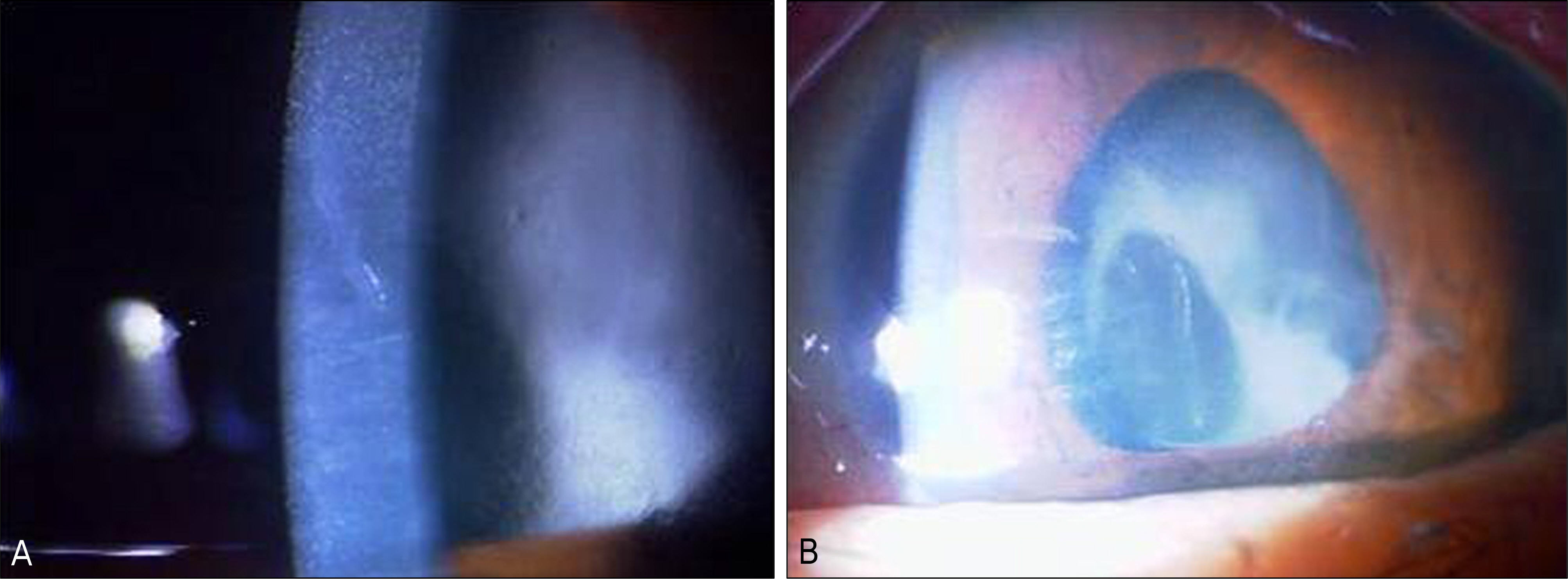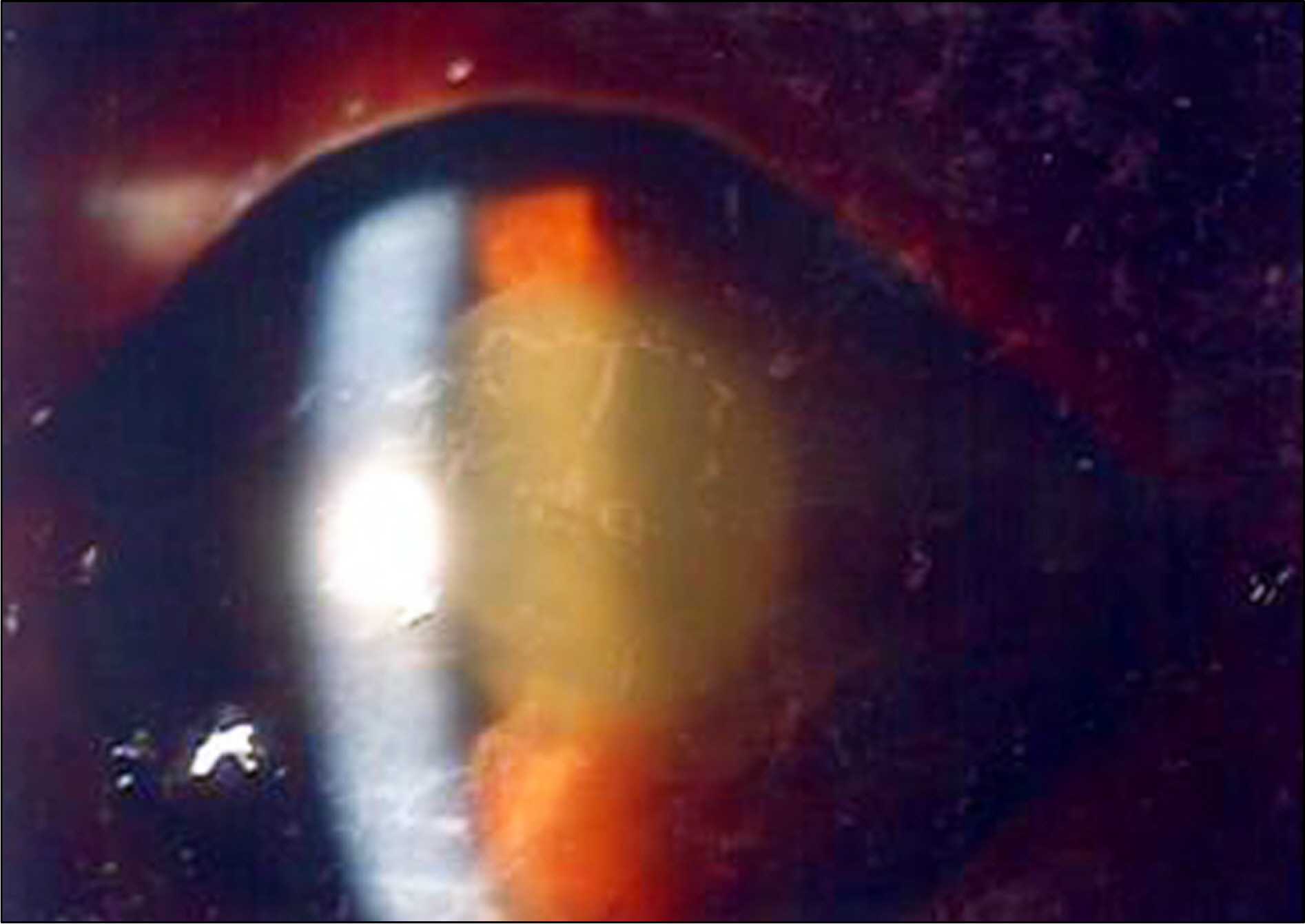J Korean Ophthalmol Soc.
2011 Jun;52(6):690-695. 10.3341/jkos.2011.52.6.690.
Toxic Anterior Segment Syndrome Following Cataract Surgery
- Affiliations
-
- 1Department of Ophthalmology and Visual Science, College of Medicine, The Catholic University of Korea, Seoul, Korea. cassiopeia-su@hanmail.net
- KMID: 2214640
- DOI: http://doi.org/10.3341/jkos.2011.52.6.690
Abstract
- PURPOSE
To report clinical and laboratory findings of toxic anterior segment syndrome (TASS) in seven patients following cataract surgery with intraocular lens (IOL) implantation.
METHODS
The medical records of seven patients who underwent cataract surgery associated with postoperative decreased visual acuity, ocular pain, anterior chamber inflammation and corneal edema between Feb 2007 and Nov 2009 were retrospectively reviewed.
RESULTS
All patients were over 60 years of age, four patients had diabetes and four patients had cardiovascular disease. Five patients had received hydrophilic IOL, and six patients underwent surgery later in order. All seven patients presented with increased anterior segment inflammation, acute decreased visual acuity, and severe corneal edema an average of 10.4 days (range 1 to 15 days) after surgery. Treatment of the seven patients included intensive topical and oral steroids, and improvement was noted in all patients.
CONCLUSIONS
The incidence of TASS after cataract surgery was 0.8%, and was significantly higher in cases of hydrophilic IOL insertion (5 of 284 cases, 1.76%) compared to cases of hydrophobic IOL insertion (2 of 581 cases, 0.34%) (p = 0.04). Five of the seven cases presented with TASS at postoperative day 14. Inflammation improved in all patients with steroid treatment.
Keyword
MeSH Terms
Figure
Cited by 1 articles
-
Pseudophakic Pupillary Block after Toxic Anterior Segment Syndrome
Chan Hong Min, Junki Kwon
J Korean Ophthalmol Soc. 2019;60(8):797-801. doi: 10.3341/jkos.2019.60.8.797.
Reference
-
References
1. Monson MC, Mamalis N, Olson RJ. Toxic anterior segment inflammation following cataract surgery. J Cataract Refract Surg. 1992; 18:184–9.
Article2. Breebaart AC, Nuyts RM, Pels E, et al. Toxic endothelial cell destruction of the cornea after routine extracapsular cataract surgery. Arch Ophthalmol. 1990; 108:1121–5.
Article3. Grimmett MR, Williams KK, Broocker G, Edelhauser HF. Corneal edema after miochol. Am J Ophthalmol. 1993; 116:236–8.
Article4. Duffy RE, Brown SE, Caldwell KL, et al. An epidemic of corneal destruction caused by plasma gas sterilization. The Toxic Cell Destruction Syndrome Investigative Team. Arch Ophthalmol. 2000; 118:1167–76.5. Liu H, Routley I, Teichmann KD. Toxic endothelial cell destruction from intraocular benzalkonium chloride. J Cataract Refract Surg. 2001; 27:1746–50.
Article6. Eleftheriadis H, Cheong M, Sandeman S, et al. Corneal toxicity secondary to inadvertent use of benzalkonium chloride preserved viscoelastic material in cataract surgery. Br J Ophthalmol. 2002; 86:299–305.
Article7. Mamalis N, Edelhauser HF, Dawson DG, et al. Toxic anterior segment syndrome. J Cataract Refract Surg. 2006; 32:324–33.
Article8. West ES, Behrens A, McDonnell PJ, et al. The incidence of endophthalmitis after cataract surgery among the U.S. Medicare population increased between 1994 and 2001. Ophthalmology. 2005; 112:1388–94.
Article9. Wallin T, Parker J, Jin Y, et al. Cohort study of 27 cases of endophthalmitis at a single institution. J Cataract Refract Surg. 2005; 31:735–41.
Article10. Montan P, Lundström M, Stenevi U, Thorburn W. Endophthalmitis following cataract surgery in Sweden. The 1998 national prospective survey. Acta Ophthalmol Scand. 2002; 80:258–61.11. Werner L, Sher JH, Taylor JR, et al. Toxic anterior segment syndrome and possible association with ointment in the anterior chamber following cataract surgery. J Cataract Refract Surg. 2006; 32:227–35.
Article12. Kim JH. Intraocular inflammation of denatured viscoelastic sub-stance in cases of cataract extraction and lens implantation. J Cataract Refract Surg. 1987; 13:537–42.
Article13. Kreisler KR, Martin SS, Young CW, et al. Postoperative inflammation following cataract extraction caused by bacterial contamination of the cleaning bath detergent. J Cataract Refract Surg. 1992; 18:106–10.
Article14. Jehan FS, Mamalis N, Spencer TS, et al. Postoperative sterile endophthalmitis (TASS) associated with the memorylens. J Cataract Refract Surg. 2000; 26:1773–7.
Article15. Meltzer DW. Sterile hypopyon following intraocular lens surgery. Arch Ophthalmol. 1980; 98:100–4.
Article16. Ratner BD. Analysis of surface contaminants on intraocular lenses. Arch Ophthalmol. 1983; 101:1434–8.
Article
- Full Text Links
- Actions
-
Cited
- CITED
-
- Close
- Share
- Similar articles
-
- Four Cases of Toxic Anterior Syndrome after Cataract Surgery under Intracameral 0.5% Lidocaine Anesthesia
- Development of Toxic Anterior Segment Syndrome Immediately after Uneventful Phaco Surgery
- Pseudophakic Pupillary Block after Toxic Anterior Segment Syndrome
- A Case of Endophthalmitis with Atypical Anterior Symptom by Subconjunctival Dexamethasone Injection after Cataract Surgery
- Differences between the Results Assessed by Slit Lamp Examination and Anterior Segment Photography in Terms of Cataract Grading



